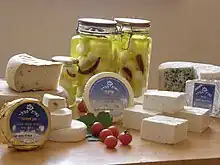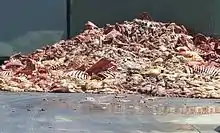Animal product
An animal product is any material derived from the body of a non-human animal.[1] Examples are fat, flesh, blood, milk, eggs, and lesser known products, such as isinglass and rennet.[2]


Animal by-products, as defined by the USDA, are products harvested or manufactured from livestock other than muscle meat.[3] In the EU, animal by-products (ABPs) are defined somewhat more broadly, as materials from animals that people do not consume.[4] Thus, chicken eggs for human consumption are considered by-products in the US but not France; whereas eggs destined for animal feed are classified as animal by-products in both countries. This does not in itself reflect on the condition, safety, or wholesomeness of the product.
Animal by-products are carcasses and parts of carcasses from slaughterhouses, animal shelters, zoos and veterinarians, and products of animal origin not intended for human consumption, including catering waste. These products may go through a process known as rendering to be made into human and non-human foodstuffs, fats, and other material that can be sold to make commercial products such as cosmetics, paint, cleaners, polishes, glue, soap and ink. The sale of animal by-products allows the meat industry to compete economically with industries selling sources of vegetable protein.[5]
The word animals includes all species in the biological kingdom Animalia, including, for example, tetrapods, arthropods, and mollusks. Generally, products made from fossilized or decomposed animals, such as petroleum formed from the ancient remains of marine animals are not considered animal products. Crops grown in soil fertilized with animal remains are rarely characterized as animal products. Products sourced from humans (ex; hair sold for wigs, donated blood) are not typically classified as animal products even though humans are part of the animal kingdom.
Several popular diet patterns prohibit the inclusion of some categories of animal products and may also limit the conditions of when other animal products may be permitted. This includes but not limited to secular diets; like, vegetarian, pescetarian, and paleolithic diets, as well as religious diets, such as kosher, halal, mahayana, macrobiotic, and sattvic diets. Other diets, such as vegan-vegetarian diets and all its subsets exclude any material of animal origin.[6] Scholarly, the term animal source foods (ASFs) has been used to refer to these animal products and by-products collectively.[7]
In international trade legislation, the terminology products of animal origin (POAO) is used for referring to foods and goods that are derived from animals or have close relation to them.[8]
Slaughterhouse waste

Slaughterhouse waste is defined as animal body parts cut off in the preparation of carcasses for use as food. This waste can come from several sources, including slaughterhouses, restaurants, stores and farms. In the UK, slaughterhouse waste is classed as category 3 risk waste in the Animal By-Products Regulations, with the exception of condemned meat which is classed as category 2 risk.
By-products in pet food
The leftover pieces that come from the process of stripping meat from animals tends to get used for different purposes. One of them is to put these parts into pet food.[9] Many large, well-known pet food brands use animal by-products as protein sources in their recipes. This can include animal feet, livers, lungs, heads, spleens, etc or an admixture in the form of meat and bone meal. These organs are usually not eaten by humans depending on culture, but are safe and nutritious for pets regardless. By-products can also include bad-looking pieces. They are always cooked (rendered) to kill pathogens.[9] Some pet food makers advertise the lack of by-products to appeal to buyers, a move criticized for contributing to food waste and reducing sustainability.[10]
Additives
- Carmine, derived from crushed cochineal beetles, is a red or purple substance commonly used in food products.[11] It is common in food products such as juice, candy, and yogurt.[12][13] The presence of carmine in these products has been a source of controversy.[14][15] One major source of controversy was the use of carmine in Starbucks frappuccinos.[16][17] Carmine is an allergen according to the FDA.[18] It takes about 70,000 female insects to produce a pound of dye.[19]
- L-cysteine from human hair and pig bristles (used in the production of biscuits, bread and dietary supplements)
- Rennet (commonly used in the production of cheese)
- Shellac (commonly used for food dye, food glaze and medicine glaze)
- Swiftlet's nest (made of saliva)
Food
- Ambrosia, also known as “bee bread” (which is made from both plant pollen and the insect’s secretions)
- Arachnids
- Blood, especially in the form of blood sausage (see also Blood as taboo food)
- Bone, including bone char, bone meal, etc.
- Broths and stocks are often created with animal fat, bone, and connective tissue
- Caviar
- Casein (found in milk and cheese)
- Civet oil (food flavoring additive)
- Dairy products (e.g., milk, cheese, yogurt, etc.)
- Eggs and egg products (e.g., mayonnaise, eggnog, custard, etc.)
- Escargot pearls
- Fat (e.g., lard, lardon, schmaltz, suet, tallow, etc.)
- Gelatin (used to make candy, ice cream, and marshmallows)
- Hard roe (as food is used as a raw or cooked ingredient in various dishes)
- Honey (including comb honey products)
- Honeydew
- Isinglass (used in clarification of beer and wine)
- Insects (some edible insects are consumed whole or made into a powder, like cricket flour. The flours are then used to make products like insect fitness bars or burger patties.)
- Kopi luwak & Black Ivory Coffee
- Meat (which includes fish, shellfish, sauces made from them, and poultry in addition to livestock, game, and "exotic dishes" made from amphibians or reptiles)
- Offal
- Skins (remaining skin scraps as a by-product of meat production or fat rendering are made profitable by being fried/roasted and sold as snacks, like; gribenes, rinds, scratchings, and rambak)
- Snake wine (also used as medicine)
- Soft roe, also known as “white roe” (commonly fried, used as an ingredient in a larger dish, or used as a condiment in some European and Asian countries)
- Whey (found in cheese and added to many other products)
Non-food animal products
- Animal fiber
- Ambergris
- Beeswax
- Bear bile (used to make medicine)
- Blood and some blood substitutes (blood used for transfusions is always human in origin, though some blood substitutes are made from animal sources. Many diagnostic laboratory tests use animal or human sourced reagents)
- Casein (used in plastics, clothing, cosmetics, adhesives and paint)
- Castoreum (secretion of the beaver used in perfumes and possibly in food flavoring)
- Civet oil
- Coral rock (Precious coral in particular is beloved for jewelry making)
- Donkey milk
- Egg oil (used in skin care products as a preservative and as skin conditioning agent)
- Emu oil (serves as a ”natural” emollient in cosmetic preparations, especially in products that claim it has the ability enhance and maintain beauty.)
- Ejaculate (used in artificial insemination)
- Feathers
- Fishmeal
- Fur
- Gallstones (from livestock for Traditional Chinese Medicine)
- Guano
- Hide
- Horse oil (used in East Asian skincare masks and creams for similar purposes as emu oil.)
- Horn, including antlers etc.
- Ivory
- Lanolin
- Limulus amebocyte lysate (a chemical in horseshoe crab blood used to detect bacterial endotoxin)
- Leather
- Manure
- Mink lashes
- Mink oil
- Musk
- Nautilus (decorative shell or pearl alternative)
- Ovine Placenta
- Pearl or mother of pearl (Treated as a precious gem for making jewelry or adorning clothing & accessories. Pearl powder is used as a natural skincare product for hydrating & healing the skin as well as lightening, brightening and maintaining youthfulness of the complexion)
- Royal jelly (used as a dietary supplement)
- Scales (fish scales are often used in makeup to impart a refractive & pearlescent finish)
- Silk
- Sponges
- Skunk oil
- Snail Mucin (used in topical medications and skincare products as a treatment for lesions and acne or as an antioxidant to brighten and hydrate the skin)
- Stearin
- Tallow, may be used in food and soap
- Tortoiseshell
- Urine
- Venom (used to produce human and veterinary antivenin)
- Whale oil
- Wool
See also
References
- Gilman, Daniel Coit; Peck, Harry Thurston; Colby, Frank Moore (1907). The New International Encyclopædia. Dodd, Mead & Co. p. 474.
- Unklesbay, Nan. World Food and You. Routledge, 1992, p. 179ff.
- "USDA ERS - Glossary". Archived from the original on February 2, 2017. Retrieved January 20, 2017.
- "Animal by-products". Archived from the original on January 15, 2021. Retrieved January 20, 2017.
- Ockerman, Herbert and Hansen, Conly L. Animal by-product processing & utilization. Technomic Publishing Company Inc., 2000, p. 1.
- Stepaniak, Joanne. Being Vegan: Living with Conscience, Conviction, and Compassion. McGraw-Hill Professional, 2000, p. 7.
- Adesogan, Adegbola (October 14, 2019). "Animal source foods: Sustainability problem or malnutrition and sustainability solution? Perspective matters". Global Food Security. 25: 100325. doi:10.1016/j.gfs.2019.100325.
- "Animals and animal products: international trade regulations". Archived from the original on January 14, 2021. Retrieved August 6, 2018.
- "Byproducts". talkspetfood.aafco.org. Archived from the original on August 24, 2021. Retrieved April 29, 2020.
- "A big pawprint: The environmental impact of pet food". Clinical Nutrition Service at Cummings School. February 8, 2018. Archived from the original on October 28, 2021. Retrieved April 29, 2020.
- Jones, Nathaniel Lee, Benji. "Yoplait strawberry yogurt is one of many foods colored with carmine, a dye made from crushed cochineal bugs". Business Insider. Archived from the original on January 24, 2022. Retrieved September 3, 2020.
{{cite web}}: CS1 maint: multiple names: authors list (link) - Pearson, Gwen (September 10, 2015). "You Know What Makes Great Food Coloring? Bugs". Wired. ISSN 1059-1028. Retrieved September 3, 2020.
- Smale, Helen Soteriou and Will (April 28, 2018). "Why you may have been eating insects your whole life". BBC News. Archived from the original on November 27, 2021. Retrieved September 3, 2020.
- "Berries Over Bugs! | Center for Science in the Public Interest". cspinet.org. July 24, 2013. Archived from the original on August 24, 2021. Retrieved September 3, 2020.
- "Conference proceedings literature added to ISI's chemistry citation index". Applied Catalysis A: General. 107 (1): N4–N5. December 1993. doi:10.1016/0926-860x(93)85126-a. ISSN 0926-860X.
- "Cochineal and Starbucks: Actually, this dye is everywhere". Los Angeles Times. April 20, 2012. Archived from the original on August 24, 2021. Retrieved September 3, 2020.
- Cruz, Kim Bhasin, Noelia de la. "Here's what you need to know about the ground-up insects that Starbucks puts in your Frappuccino". Business Insider. Archived from the original on November 9, 2021. Retrieved September 3, 2020.
{{cite web}}: CS1 maint: multiple names: authors list (link) - "Why You Should Never, Ever Give Red Candies To Your Valentine". HuffPost. February 13, 2014. Archived from the original on June 28, 2021. Retrieved September 3, 2020.
- "Is it true that some candies are coloured with insect extract?". Office for Science and Society. Archived from the original on August 24, 2021. Retrieved September 3, 2020.
Further reading
- Extensive list identifying animal-derived and vegan ingredients
- FDA Consumer Magazine: The Lowdown on Labels
- Heinz, G. & Hautzinger, P. "Meat Processing Technology" Archived February 7, 2019, at the Wayback Machine, Food and Agriculture Organization, 2007, accessed March 30, 2012.
- Leoci, R., Animal by-products (ABPs): origins, uses, and European regulations, Mantova (Italy): Universitas Studiorum, 2014. ISBN 978-88-97683-47-6
- Mian N Riaz, Riaz N Riaz, Muhammad M Chaudry. Halal Food Production, CRC Press, 2004. ISBN 1-58716-029-3
- Tsai, Michelle. "What's in a can of dog food?, Slate, March 19, 2007.
- Earthly Origin of Materials, is a material animal, vegetable, or mineral?
